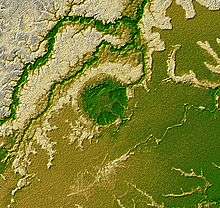Iturralde Crater

Iturralde Crater (also called Araona Crater) is a 5-mile (8 km) diameter circular feature in the Bolivian portion of the Amazon Rainforest, first identified from Landsat satellite imagery in 1985.[1][2] Being so circular, it is argued by some scientists that it may be a meteorite impact crater. Because it is in an area of active sediment accumulation by rivers, it must be a geologically young feature, with estimates of its age ranging between 11,000 and 30,000 years.[1] Unlike other young craters, it is very flat, so if it is of impact origin, perhaps the crater sunk into the soft sediments leaving only a circular 'ghost' marking the original rim. The site is very remote, but has been visited twice by scientific investigators, most recently by a team from NASA's Goddard Space Flight Center in September 2002.[3][4] In both cases, the expeditions failed to find conclusive evidence for the origin of the feature.
References
- 1 2 NASA Educational Brief. Retrieved on 2007-02-19.
- ↑ Goddard Scientific Visualization Studio. Retrieved on 2007-02-19.
- ↑ ICE2002 Expedition. Retrieved on 2007-02-19.
- ↑ 'Top Story' at Goddard Space Science Center. Retrieved on 2007-02-19.
External links with images of Iturralde
- NASA Earth Observatory: Topographic Map of the Iturralde Structure, Bolivia
- NASA Earth Observatory: Iturralde Crater, Bolivia
Coordinates: 12°35.2′S 67°40.5′W / 12.5867°S 67.6750°W